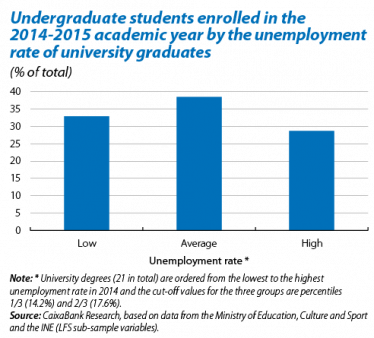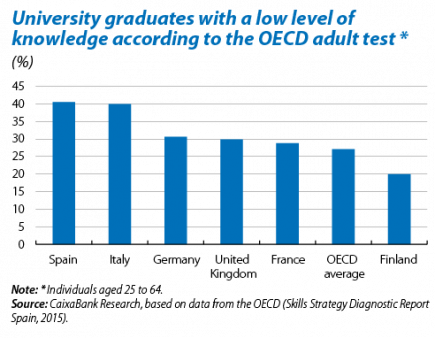An analysis of the employability of Spain's labour force
The capacity of individuals to get a job and progress professionally, in other words their employability, will be decisive in reducing Spain's high unemployment rate, which stood at 21.2% in 2015 Q3. This Focus analyses the employability of the Spanish labour force in order to detect the main areas for improvement.
One key factor in increasing the likelihood of those joining the labour market finding a job is for their training to be in line with the market's demand. In this respect, it would be advisable if those university degrees attracting a higher number of students had a lower unemployment rate. However the most recent data, from the 2014-2015 academic year, show that this is not the case: almost 30% of undergraduates are concentrated in the areas of education within the highest unemployment tercile, such as architecture and art whereas degrees with relatively low unemployment, such as mathematics or statistics, receive less than 1% of the enrolments (see the first graph). It therefore seems that better coordination between the supply for places in higher education and the demand for labour could help to improve the employability of those entering the labour market.
Another fundamental factor that determines employability is for the training received to develop the skills required to carry out a specific job. According to OECD data from 2015, 41% of adults with higher qualifications achieved a low result in the professional skill test, compared with 27% for the OECD average (see the second graph). The level of knowledge of the adult population therefore seems to be limited, even among those holding third cycle degrees, warranting a review of the educational programmes imparted.1
The situation becomes even more worrying if we consider that, in the last few years, the population has become polarised into two groups: those who have not completed medium level studies and those graduating from higher education, resulting in a significant deficit of workers with medium-level qualifications. This bipolar distribution of educational attainment contrasts with the situation observed in other countries. In 2015 Q2, while only 22% of Spaniards aged between 25 and 64 had medium-level qualifications, this percentage was 59% in Germany. However, 43% of Spain's population in this age group had a low level of educational attainment compared with 13% in Germany.
The low percentage of individuals with medium-level qualifications in Spain is the result of the high school drop-out rate and low use of the vocational education (VE). On the one hand, the percentage of «NEET» (young people who are hot in education, employment or training) is still very high in Spain (27% compared with 15% on average for the OECD). On the other hand, the share of VE is low and, consequently, so is the share of the population with job-specific skills. In this respect, t0he reform of VE in 2011 (Royal Decree 1147/2011) took some steps in the right direction by making it easier, for example, to move from academically-focused secondary education (ESO) to VE, which should help to reduce the number of people leaving school without any qualifications. However, the medium-level VE still has problems matching the demand for labour, largely due to the limited collaboration between those designing the programmes and companies. In short, focusing on policies that help to increase the employability of the labour force will be crucial to reduce the country's high unemployment.
1. See García Perea, P. and Molinas, C. (2015), «Acabar con el paro ¿queremos? ¿Podremos?», Fundación de Estudios Financieros.




